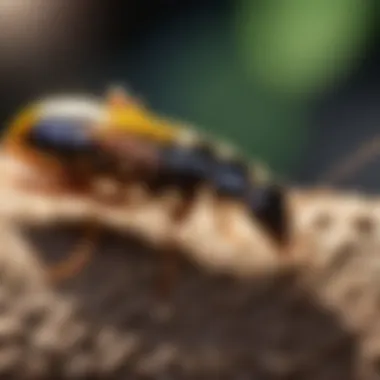Materials:
- Pesticide spray: Purchase a high-quality pesticide specifically formulated for earwig control. Ensure to read and follow the manufacturer's instructions for proper dilution ratios.
- Protective gear: Gloves, mask, and safety glasses are essential to shield yourself from pesticide exposure.
- Sprayer: Use a handheld sprayer or a pump sprayer for precise application of the pesticide.
- Sealant: Silicone caulk or weatherstripping to seal any cracks or entry points where earwigs may crawl in.
DIY Steps:
- Preparation: Thoroughly inspect the perimeter of your home for possible entry points and breeding areas. Clean up debris and mulch to discourage earwig nesting.
- Application: Mix the pesticide as per the instructions provided. Apply the solution along the foundation of your house, focusing on areas where earwigs are prone to hide.
- Interior Treatment: Treat entry points like doors and windows and concentrate on dark, damp areas like basements and crawl spaces which are favorable spots for earwig infestation.
- Post-Application: Allow the pesticide to dry completely before allowing children or pets in the treated areas. Reapply as needed according to the pesticide's guidelines.
Technical Aspects:
- Tools: You will need a measuring cup for accurate mixing, a ladder for elevated spraying, and a flashlight for inspecting dark corners.
- Timing: Apply the pesticide during the early morning or late evening when earwigs are most active.
- Techniques: Ensure even coverage of the pesticide, and pay attention to areas near water sources and vegetation which attract earwigs.
DIY Project Process:


- Installation: Start by mixing the pesticide in a well-ventilated area following the instructions carefully.
- Spray Application: Using the sprayer, apply the pesticide around the foundation, paying close attention to hiding spots such as cracks and crevices.
- Indoor Treatment: Move indoors to target any visible earwigs, focusing on areas where moisture levels are high.
Troubleshooting Tips:


- If you notice a persistent infestation after treatment, reevaluate your pest control strategy and consider seeking help from a professional exterminator.
- Ensure proper ventilation during application to minimize your exposure to the pesticide fumes.
- Keep children and pets away from treated areas until it is safe for them to re-enter.
Understanding Earwigs and The Need for Pest Control


Earwigs are elusive insects that often become unwelcome guests in gardens and homes. Understanding their behavior and the implications of their presence is crucial for effective pest control. In this article, we delve into the intricate details of earwigs, shedding light on why eradicating them is essential for preserving plant life and maintaining a pest-free environment. By comprehending the habits and impact of these creatures, individuals can implement targeted strategies to combat infestation and protect their living spaces.
Introduction to Earwigs
What are Earwigs?
Earwigs, scientifically known as Dermaptera, are characterized by their long slender bodies and formidable pincers located at the end of their abdomen. Despite their menacing appearance, these insects primarily feed on decomposing plant and animal matter, serving as valuable decomposers in ecosystems. However, their penchant for feasting on living plants makes them a nuisance for gardeners and homeowners. Understanding the ecological niche of earwigs is vital for devising tailored pest control solutions.
Identification and Behavior
Earwigs are known for their nocturnal habits, seeking shelter in dark, moist crevices during the day and emerging at night to feed. Their distinct cerci, forceps-like structures located on their abdomens, play a role in defense and courtship. By grasping the nuances of earwig behavior, individuals can better anticipate infestation patterns and mitigate risks effectively.
Impact of Earwigs on Gardens and Homes
Destruction of Plants
Earwigs pose a significant threat to plant life, particularly young seedlings and delicate foliage. Their voracious appetite for tender plants can result in stunted growth, leaf damage, and even plant death. By targeting vegetation at its most vulnerable stages, earwigs can impact the overall health and aesthetics of gardens, necessitating prompt intervention to safeguard plant vitality.
Indoor Infestation Risks
While earwigs primarily dwell outdoors, they may find their way indoors in search of shelter and sustenance. Homes with conducive environments, such as damp basements or cluttered spaces, are particularly susceptible to earwig intrusion. Once inside, these insects can cause distress to residents and potentially contaminate food items. Understanding the potential risks of indoor earwig infestation is crucial for implementing preventive measures to maintain a hygienic household.
Why Pesticides are Essential for Earwig Control
Challenges of Natural Repellents
Despite the availability of natural repellents, such as diatomaceous earth or citrus sprays, combating earwig infestations with these methods poses challenges. The transient nature of natural products, coupled with varying effectiveness levels, often necessitates repeated applications and may yield inconsistent results. While environmentally friendly, these repellents may not provide the robust defense required for severe infestations.
Effectiveness of Pesticides
Pesticides offer a potent solution for managing earwig populations, providing targeted eradication with lasting effects. Formulated to tackle specific pests, insecticides designed for earwigs can deliver rapid and comprehensive control. By harnessing the potency of pesticides, individuals can address earwig infestations efficiently, safeguarding plant health and property integrity.
Choosing the Right Pesticide for Earwig Eradication
When delving into the realm of eradicating earwigs, an essential aspect to consider is selecting the appropriate pesticide for this task. The choice of pesticide plays a pivotal role in the effectiveness of pest control measures. Among the myriad options available, each type of pesticide offers distinct advantages and considerations that cater to different aspects of eliminating earwigs. Understanding these nuances is crucial to ensure successful eradication without causing harm to the environment or non-target species.
Types of Pesticides Effective Against Earwigs
Contact Insecticides
Contact insecticides are a key player in the battle against earwigs. These pesticides work by direct contact with the insect, disrupting their functioning and ultimately leading to their demise. One of the key characteristics of contact insecticides is their fast-acting nature, providing immediate results upon application. This rapid response makes them a popular choice for controlling earwig infestations efficiently. However, a potential drawback of contact insecticides is their limited residual effect, necessitating more frequent applications to maintain efficacy.
Ingested Insecticides
Ingested insecticides offer a different approach to combating earwigs by targeting their feeding behavior. Once ingested by the earwigs, these pesticides disrupt their internal systems, leading to their extermination. The standout feature of ingested insecticides lies in their ability to provide long-term control, making them an attractive option for sustained pest management. However, the downside of ingested insecticides may include a slower onset of action compared to contact insecticides, requiring patience for optimal results.
Residual Sprays
Residual sprays serve as a valuable tool in the arsenal against earwigs, offering lasting protection against these pesky pests. These sprays create a barrier that remains effective for an extended period, ensuring continuous control of earwig populations. The key benefit of residual sprays is their enduring effect even after application, providing a shield against future infestations. Despite their effectiveness, improper application or overuse of residual sprays may pose risks to non-target species and the environment, warranting careful consideration during deployment.
Considerations When Selecting a Pesticide
Impact on Non-Target Species
Consideration of the impact on non-target species is paramount when selecting a pesticide for earwig control. Opting for pesticides with minimal impact on beneficial insects or organisms ensures the preservation of ecological balance. The ability to target earwigs specifically while safeguarding other wildlife underscores the importance of choosing pesticides that minimize collateral damage. However, even pesticides deemed safe for non-target species may still pose some risks, necessitating proper application and adherence to safety guidelines to mitigate unintended consequences.
Environmental Factors
Environmental factors play a significant role in determining the suitability of pesticides for earwig eradication. Factors such as weather conditions, proximity to water bodies, and potential runoff effects must be taken into account to prevent ecological harm. Choosing pesticides that have low environmental persistence and reduced toxicity to aquatic life can help mitigate adverse effects on the environment. By considering these environmental factors, individuals can make informed decisions that prioritize both effective pest control and environmental stewardship.
Application Techniques for Maximum Effectiveness
In the realm of pest control, mastering the application techniques is paramount to achieving optimal results. This section delves into the core importance of maximizing the effectiveness of pesticide application in eradicating earwigs, offering a detailed roadmap for success. By understanding and implementing the proper application techniques, individuals can ensure thorough coverage and penetration of the targeted areas, leaving no room for pest resurgence. Emphasizing precision and consistency in application methods can significantly boost the eradication process, leading to a satisfactory outcome in pest management. Furthermore, selecting the appropriate application techniques plays a vital role in minimizing environmental impact while maximizing efficacy, showcasing the significance of this aspect in the overall efficacy of pest control strategies.
Optimal Timing and Frequency of Pesticide Application
Seasonal Considerations
Seasonal considerations play a crucial role in determining the most effective timing for pesticide application. Understanding the unique behaviors and reproductive cycles of earwigs during different seasons enables homeowners to strategize their pest control efforts effectively. For instance, targeting earwigs during their peak breeding seasons can yield higher success rates in eradicating infestations. Furthermore, adjusting the frequency of pesticide application in accordance with seasonal changes can ensure sustained protection against earwigs and prevent re-infestation. Seasonal considerations, therefore, offer a nuanced approach to pest management by capitalizing on the vulnerabilities of earwigs during specific times of the year, emphasizing the strategic timing of pesticide application as a key driver of success.
Monitoring Strategies
Monitoring strategies serve as an indispensable component of effective pest control efforts, providing valuable insights into pest activity levels and infestation patterns. By implementing robust monitoring techniques, homeowners can actively track the impact of pesticide applications and make informed decisions regarding subsequent treatment plans. Regular monitoring also enables early detection of any resurgence or new infestations, allowing for prompt intervention and prevention of widespread pest issues. By utilizing monitoring strategies as a proactive tool in pest management, individuals can maintain a proactive stance against earwigs and ensure the long-term success of their eradication endeavors. The detailed and systematic approach offered by monitoring strategies enhances the efficacy of pest control measures, underscoring its significance as a cornerstone of successful pesticide application.
Proper Application Methods
Spraying Guidelines
The accurate execution of spraying guidelines is pivotal in ensuring the even distribution and coverage of pesticides across targeted surfaces, effectively eliminating earwig populations. Following established spraying protocols meticulously guarantees that the intended areas receive adequate pesticide doses, leaving no room for pests to escape treatment. Moreover, adherence to spraying guidelines minimizes wastage of pesticides and reduces the risk of environmental contamination, underlining the importance of precision in application methods. By incorporating spraying guidelines into pest control practices, individuals can streamline the eradication process and achieve comprehensive protection against earwigs, reflecting the pivotal role of this method in successful pest management.
Baiting Techniques
Baiting techniques offer a strategic approach to attracting and eradicating earwigs by luring them with bait stations or traps containing pesticide-laced bait. This targeted method allows for the selective elimination of earwig populations without dispersing pesticides broadly, enhancing the precision and effectiveness of pest control efforts. By deploying baiting techniques strategically in areas prone to earwig infestations, homeowners can achieve localized pest reduction and minimize the impact on non-target species. Additionally, baiting techniques provide a proactive approach to pest control by enticing earwigs to specific locations, facilitating their targeted extermination and preventing further damage to surrounding vegetation. Incorporating baiting techniques into pest control strategies underscores the value of employing diverse application methods to combat earwig infestations comprehensively, showcasing the versatility and efficacy of this approach in pest eradication.
Safety Measures When Dealing with Pesticides
When it comes to eradicating earwigs using pesticides, safety measures play a crucial role in ensuring that the process is effective and harm-free. Addressing safety concerns is paramount in this article as it is essential to protect both the environment and the individuals applying the pesticides. By emphasizing Safety Measures When Dealing with Pesticides, we highlight the responsibility that comes with using these types of chemicals. This section delves into the specific elements, benefits, and considerations related to safety when using pesticides.
Protective Gear and Precautions
Appropriate Clothing
Appropriate Clothing is a fundamental aspect of safety when dealing with pesticides. Choosing the right clothing is essential to prevent skin contact and minimize exposure to harmful chemicals. The key characteristic of Appropriate Clothing lies in its protective nature, shielding the wearer from potential hazards. Its breathable fabric and durable construction make it a popular choice for individuals handling pesticides during the eradication process. Appropriate Clothing provides a barrier against pesticide absorption into the skin, reducing the risk of adverse health effects. While it offers excellent protection, some disadvantages include the need for proper cleaning and disposal after use.
Respiratory Protection
Respiratory Protection is another critical component of safety measures when using pesticides. It helps safeguard individuals against inhaling toxic fumes or particles that can pose health risks. The key characteristic of Respiratory Protection is its ability to filter out harmful substances from the air, ensuring clean and safe breathing conditions. This safety equipment is a beneficial choice for anyone exposed to pesticide sprays or vapors, minimizing the potential respiratory-related issues. The unique feature of Respiratory Protection lies in its adjustable straps and comfortable fit, enhancing user compliance. While it provides essential protection, some disadvantages include the need for proper maintenance and regular replacement of filters.
Storage and Disposal Guidelines
Safe Storage Practices
Safe Storage Practices are imperative to maintain the integrity and effectiveness of pesticides while avoiding accidental exposure. Properly storing pesticides in designated areas ensures that they remain out of reach of children and pets, minimizing the risk of unintended ingestion. The key characteristic of Safe Storage Practices is the organization and labeling of pesticide containers, facilitating easy identification and preventing misuse. This practice is a popular choice for safeguarding both the environment and individuals involved in pest control activities. The unique feature of Safe Storage Practices includes the use of locked cabinets and secure shelving, providing an added layer of protection. While it offers numerous advantages, some disadvantages may include the need for regular inventory checks and disposal of expired products.
Proper Disposal Methods
Proper Disposal Methods are essential for responsible pesticide usage and environmental protection. Disposing of pesticides properly prevents contamination of soil and water sources, reducing negative impacts on ecosystems. The key characteristic of Proper Disposal Methods is the compliance with local regulations and guidelines to ensure safe handling and disposal of chemical waste. This practice is a beneficial choice for mitigating potential risks associated with pesticide remnants and unused products. The unique feature of Proper Disposal Methods includes the use of specialized disposal sites or collection programs, promoting sustainable waste management practices. While it offers significant advantages, some disadvantages may involve additional costs for disposal services and the need for proper training on waste disposal protocols.





